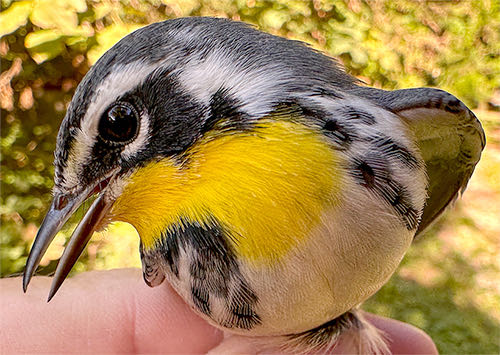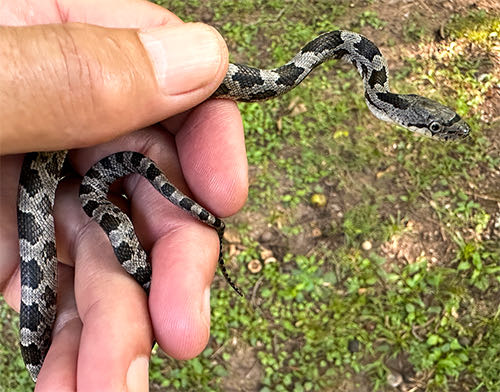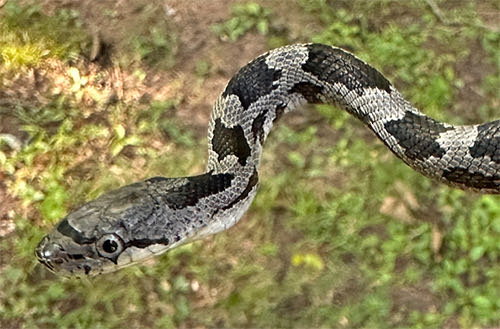- Established 1982 -HOME: www.hiltonpond.org
THIS WEEK at HILTON POND Subscribe for free to our award-winning nature newsletter (Back to Preceding Week; on to Next Week) |
LATE MALE HUMMER, A hatch-year male Ruby-throated Hummingbird (RTHU, below) trapped on 20 September was the 300th of his species banded here in 2023, only the second time we'veve reached that number in 40 years of studying hummers at Hilton Pond Center. That's a LOT of hummingbirds, but at this late date it's unlikely we will equal our phenomenal record total of 373 set in 2016. (NOTE: We banded 319 RTHU through the end of September this year.)
All text, maps, charts & photos © Hilton Pond Center This latest young male ruby-throat had just two metallic red gorget feathers (one doesn't show in the image). In coming months he'll bring in more red while on his Neotropical non-breeding grounds and return next spring with a full gorget, ready to attract and mate with females. The newly banded bird in the photo has also been marked with temporary non-toxic green dye to avoid our recapturing him over and over in pull-string traps baited with sugar water. The band wouldn't be visible but the color mark is, minimizing wear and tear on any "trap junkie hummer" that enters the same trap repeatedly--sometimes dozens of times per day. The unique green mark also offers opportunities for folks elsewhere to spot one of "our" hummers during migration and to report them to us at RESEARCH. All text, maps, charts & photos © Hilton Pond Center AN UNCOMMON FALL WARBLER Fall bird migration at Hilton Pond Center was well underway during September's second half. We banded 25 species (see complete list at the end of this week's installment), of which only six were certain to be year-round residents. Those included Carolina Chickadee, Northern Cardinal, Carolina Wren, House Finch, White-breasted Nuthatch, and Downy Woodpecker. (Eastern Phoebe and Black-and-white Warbler were other possible permanent residents.) The remainder were all summertime breeders or pass-through migrants from points north--some of which we see rarely and for only a short period in autumn.
All text, maps, charts & photos © Hilton Pond Center One of the Center's least commonly banded birds to show up this week was a Yellow-throated Warbler (YTWA, above), a species for which we've banded just 16 individuals since 1982--only six of them in fall. Through the years we've captured one female YTWA with a brood patch--indicating local nesting--but we suspect most of our encounters have been migrants. (NOTE: One reason we seldom catch Yellow-throated Warblers may be because they dwell high in the tree canopy, meaning they seldom come down to ground level where our mist nets are deployed. Maybe that's also why this species is always so squirmy, making it hard to get an in-hand photo!) Some Yellow-throated Warblers coming through Hilton Pond Center may not be going far, since a relative few do overwinter on the South Carolina coast and down to Florida rather than flying all the way to Central America or the Caribbean. Going back north to breed in spring they barely get past the latitude of Chicago or Pittsburgh and are seldom seen at all in the Appalachian Mountains. All text, maps, charts & photos © Hilton Pond Center AN INDOOR SNAKE: One afternoon this week we entered the kitchen of our old farmhouse at Hilton Pond Center and noticed an out-of-place dark object on the floor beside the stove. When it moved we quickly realized it was a snake and could tell right away the species.
All text, maps, charts & photos © Hilton Pond Center The intruder, with its rectangular dark brown blotches against a gray background, was an immature Eastern Rat Snake, Pantherophis alleghaniensis, formerly known as Black Rat Snake, Elaphe obsoleta. People are forever wanting to misidentify these snakelings as venomous Copperheads, whose hourglass markings on a coppery background look nothing like a rat snake. The youngsters also don't resemble their adult parents that are glossy black with a white chin.
All text, maps, charts & photos © Hilton Pond Center Lest this little intruder slither out of sight, we moved quickly to grab it without any fear of being bitten. A snake this small--about 10"--could hardly cause any damage even if it did clamp down on one's finger. It did demonstrate its inborn ability as a constrictor, wrapping tightly around our fingers as we admired its large head, big eyes, and slender neck. We suspect this immature serpent is the offspring of much larger adult Eastern Rat Snakes that patrol our crawlspace and attic. In both locations we frequently find shed skins up to six feet long--a good sign these creatures are helping control White-footed Mice that inevitably come with having a farmhouse in the country. After capture, we took our snakeling to our outdoor compost pile for release; there it undoubtedly would find prey items attracted to table waste we also send back to nature. All text, maps, charts & photos © Hilton Pond Center CUCKOOS IN TWOS When we approached one of our mist nets on 20 September we noticed a large-ish bird had been snared and was squirming around in the mesh. We moved quickly to extract it and realized immediately it was an immature yellow-billed Cuckoo--a species we rarely capture at Hilton Pond Center (only 58 banded in 42 years). As we carefully removed the fine strands from the bird's wings, head, and feet it started squawking loudly, at which point a second cuckoo swooped down and also got caught. Holding the first bird securely with one hand we were able to quickly extricate the second one, after which we hand our hands full of cuckoos. We suspect the second bird was a defensive parent come down to see what was messing with its offspring.
All text, maps, charts & photos © Hilton Pond Center Back at the banding table in the Center's old farmhouse we transferred the second bird to a holding bag and got to work on banding the initial capture. Based on plumage we could tell it was an immature bird and confirmed its age by a pink lining to its upper mandible--black in breeding adults. In typical Cuckoo Family fashion (Culculidae) its white-tipped tail feathers were progressively shorter from inner to outer. Most summers we hear a cuckoo's single-knock call repeated all day long dawn to dusk; less often it's that slow "cuck-cuck-cuck-cuck-cuck-cuck-cuck." It's hard to know just how many Yellow-billed Cuckoos there are any year at Hilton Pond Center, but we've watched one vocal individual move slowly across the 11-acre property from one canopy tree to the next--suggesting we may host only one breeding pair per season. (NOTE: We've seen the closely related Black-billed Cuckoo here a few times through the years and banded only two, one each in 1986 and 1991. Both our cuckoo species are in steep decline but things seem especially dire for the black-bill.) Our late birding friend Jim Shuman always said--quoting the words of his own father Ruhl--that cuckoos "slurk around." It's hard to define this term but it seems to fit as the cuckoo's slumped posture and stealthy movement through the trees is almost serpentine. All text, maps, charts & photos © Hilton Pond Center HILTON POND SUNSETS "Never trust a person too lazy to get up for sunrise
Sunset over Hilton Pond, 16 September 2023 For Amy Lou and Kimmy Sue, visiting from Shawnee Hills OH to celebrate the 77th birthday of Dr. Bill Hilton Jr.
Sunset over Hilton Pond, 26 September 2023 September brought some excellent sunsets like this one, with deep blue skies and clouds write in reddish-orange. All text, maps, charts & photos © Hilton Pond Center Don't forget to scroll down for lists of Hilton Pond supporters and of all birds banded and recaptured during the period. Photoshop image post-processing for this page employs |
|---|
|
"This Week at Hilton Pond" is written and photographed by Dr. Bill Hilton Jr., executive director of Hilton Pond Center for Piedmont Natural History
|
|
|
Please refer "This Week at Hilton Pond" to others by clicking on this button: |
|

















 Please report your spring, summer &
Please report your spring, summer &